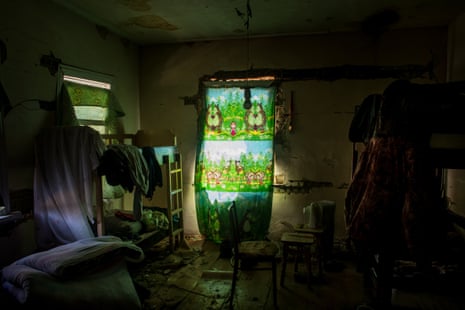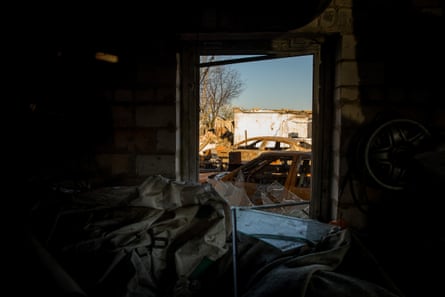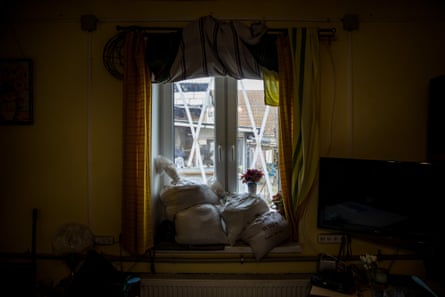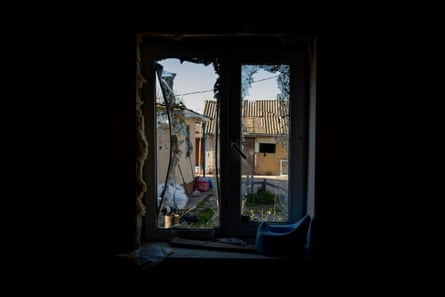[ad_1]
Bright sunlight filters through a cheerful green curtain onto a chaotic room, with a bunk bed against one wall. Immediately, you know two things: children sleep here and their world is in a mess. The curtains are printed with cartoons of a little girl in red and a big brown bear. They’re from Masha and the Bear, explains the photographer Miguel Gutiérrez. It’s a Russian animation that paradoxically uses the adventures of a girl and a bear to teach values such as respect, and the importance of care and integration between children and adults.
The photograph was taken in the Ukrainian village of Rozhivka, near Kyiv, in the home of a farming family, says Gutiérrez. “They said that while they were sleeping, they were attacked. They did not understand what was happening, because they do not live in a military or strategic zone; they only understood that they needed shelter. The artillery hit the back yard and the ceiling of their home, affecting the children’s bedroom.”

The picture is one of a series, Windows of Horror, that won the Venezuelan photojournalist a place on the shortlist for a prestigious Sony World Photography award. After the Russian invasion of Ukraine in February 2022 and his news agency, EFE, called for volunteers to go, Gutiérrez was among the first to put his hand up, even though it took three planes, a train and a car journey to get there from his home in Caracas. At that time, a new war was almost unthinkable, he recalls: “At least not of this kind. We talk about technological or commercial wars, but not those that remind us of the 20th century. For many years we have been accustomed to war in developing countries, and we never thought that in developed countries we would witness such a situation.”
Though there are no people in these pictures, they tell a powerful human story. “Our task was to tell the big news story, but at the same time to show the human side, day by day, by chronicling what the ordinary people were going through. I wanted to find a way to involve the viewer in the war, so that someone in another country or continent could be in the shoes of those who live in those houses. There are shocking photographs of what the Ukrainians are enduring, but with this series, I wanted to transport people to an area under attack that was not a military base. To show that no one in Ukraine is safe.”

He chose to focus on ordinary homes because “a house is a symbol of work, of effort, of a goal achieved. I wanted to show the war from Ukrainian homes; to show the perspective of citizens: how they live in their homes and what they see through their windows. There is war inside and outside every Ukrainian house. Through windows, everyone can witness the horror, but at the same time it is a reminder that, through them, you can find the light to overcome any adversity.”
He is well aware of the trust that people are placing in him when they invite him into their homes. “In different cultures, it was believed that taking a photograph of someone stole part of their soul. For me, it is to create a historical bond with those whom I photograph. There is a link with the inhabitants of these homes, despite them not being in the photos. Personal and intimate spaces are now becoming global evidence of the horror of war. But the Ukrainians are asking the world for help, and are very open to telling what they are living through.”

One picture, of a heavily sandbagged window (directly above), was taken in a room belonging to a young man with Down’s syndrome, Valentyn Radchenko. “Apart from taking refuge in the basement of his house, he would take refuge in the paintings he made,” says Gutiérrez. “His mother says they tried to maintain their normal routine, but anti-aircraft alarms made them anxious and stopped them sleeping; and only in his painting could this young man find any peace of mind.”
Gutiérrez was born in Bogotá, Colombia, in 1983, but his family emigrated to Venezuela when he was a teenager. “This is my first large-scale conflict but, after photographing a country as complicated as Venezuela, I felt ready for it,” he says. “Venezuela has suffered years of turmoil in which civilians have faced police forces in full political protests, leaving people dead in the streets, coupled with the social crisis that this country is experiencing.”
Living with this daily reality has shaped his aesthetic. “I’m a journalist, but my way of communicating is through photography. Stories can be simple in words but powerful visually, and the image expands the story that you want to tell. I have developed this type of work – almost conceptual – for some years, because telling a literal story of the crisis in a country like Venezuela can be redundant, so you have to look for different ways to show reality.”

While in Lviv in western Ukraine, he made another series of photographs of people fleeing their homes. “I asked them to show me the most important thing they had taken with them. A photo album, a wedding handkerchief, a meditation bowl, religious prints, a dog… these things connect directly with whoever sees the portraits.”
He was only in Ukraine for a little over a month, but is in no doubt that he has been changed by what he has witnessed. “A war does not leave anyone indifferent, and my perspective on the problems has totally changed: problems both as a professional and as a human. We have only one life, and we must live it in a good way.”
[ad_2]
READ SOURCE


